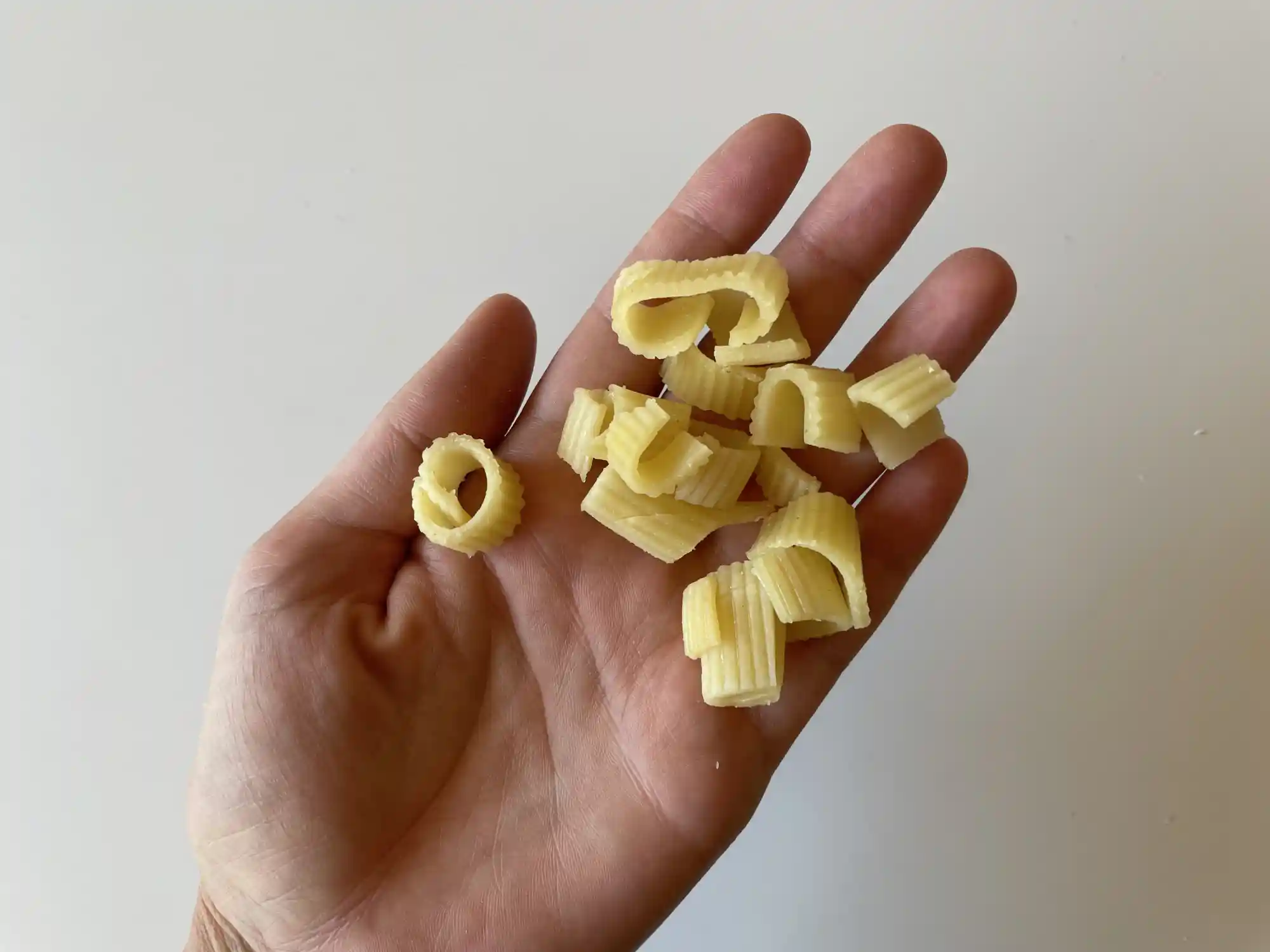Access our First Foods® Database in the Solid Starts App.
Learn more
When can babies have pasta?
Pasta may be introduced as soon as a baby is ready to start solids, which is generally around 6 months of age. Take care when introducing pasta if you haven’t already introduced egg or wheat into baby’s diet yet, as pasta often contains both egg and wheat, which are common food allergens.
Pasta or noodles? Both terms refer to unleavened dough made of starch and liquid, formed into any number of shapes, boiled quickly, and flavored with sauce and spice. The word “pasta” comes from Italy, while the term “noodles” is used interchangeably by some to describe not only pasta, but mian, ramen, soba, udon, and other dishes made in East Asia since ancient times.
Which pasta shapes are best for babies?
Every baby develops on their own timeline, and the suggestions on how to cut or prepare particular foods are generalizations for a broad audience.
6 months old +:
Offer large pieces of flat, wide noodles or whole pieces of large tubular pasta, such as penne, rigatoni, or ziti. Pasta may be slippery and a little tough to hold on to with the immature grasp at this age. You may also chop spaghetti and other thin noodle shapes and serve in a bowl for hand scooping. Tip: Use kitchen shears to cut noodles in your child’s bowl to save time (and dishes).
9 months old +:
At this age babies develop the pincer grasp (where the thumb and pointer finger meet), enabling them to pick up smaller pieces of food. Cut large, tubular pastas in half, or offer macaroni, quartered ravioli, or chopped noodles. If baby is having a hard time picking up the pasta, it’s okay to continue to serve whole pieces of large, tubular pasta. Doing so will help advance biting and chewing and grinding skills.
12 months old +:
At this age, toddlers may be more adept at working with long, thin noodles like spaghetti, ramen, and rice noodles. Explore a wide variety of noodle shapes and textures, cutting into smaller strands as needed (again, scissors work beautifully here). Don’t worry if a toddler still prefers to scoop noodles with their hands—that’s okay. Simply continue to offer an age-appropriate utensil for opportunities for the child to practice.


How to choose and serve pasta for babies 6 months +
How to serve pasta for babies 9 months +
How often should you offer solids? See our sample feeding schedules for babies of every age.
Videos
Is pasta a choking hazard for babies?
No. Pasta presents a low risk when safely prepared for a child’s age and developmental ability, though, in theory, an individual could choke on any food. To reduce the risk, prepare and serve pasta in an age-appropriate way. Note that pasta can cause gagging, especially when served plain, without a sauce. To make it easier to swallow, serve pasta with a sauce, or stir in a bit of oil. As always, make sure you create a safe eating environment and stay within an arm’s reach of baby during meals.
Learn the signs of choking and gagging and more about choking first aid in our free guides, Infant Rescue and Toddler Rescue.
Is pasta a common allergen?
Yes. Pasta and noodles often contain egg and wheat, which are common food allergens.
Prior to sharing pasta with baby, it is important to introduce any relevant common allergens on their own and rule them out as allergies before serving them together in a prepared food like pasta. This way, you’ll be able to identify which allergen is responsible if baby has a reaction. Then, when you are ready to offer pasta, you will be confident that they have already safely eaten any common food allergens in the dish.
As you would when introducing any new food, start by offering a small quantity for the first few servings. If there is no adverse reaction, gradually increase the quantity over future meals.
Is pasta healthy for babies?
Yes—with some types offering more nutrition than others. Generally pasta made from legume flour (black bean pasta, chickpea pasta, lentil pasta) is more nutrient-dense than pasta made from rice and wheat flours. Enriched pasta will also offer even more nutrients like iron and some B vitamins. All pasta, no matter the type, offers ample carbohydrates to energize a baby’s growing body, and when it is served as part of a well-balanced diet with plenty of whole foods, pasta can be a perfectly healthy addition to a baby’s meal.
Pasta types by key nutrients
The following is a table of common pastas and their nutritional value by key ingredients, using data from USDA’s FoodData Central unless otherwise specified, accessed February 4, 2021.
Per ¼ cup child-sized serving | ||||||
Legume Pasta | Carbs (g) | Fiber (g) | Protein (g) | Iron (g) | Zinc (g) | Folate (mg) |
Black Bean Pasta | 9.3 | 2.5 | 3.0 | 0.7 | n/a | n/a |
Chickpea Pasta | 9.3 | 2.0 | 3.0 | 0.6 | n/a | n/a |
Lentil Pasta | 8.8 | 1.3 | 3.3 | 0.9 | n/a | n/a |
Mung Bean Noodles | 9.8 | 0 | 0 | 0.2 | 0.04 | 0 |
Enriched Pasta | ||||||
Enriched Egg Noodles | 10.1 | 0.5 | 1.8 | 0.6 | 0.3 | 33.5 |
Enriched Wheat Pasta | 10.8 | 0.6 | 2.0 | 0.4 | 0.2 | 25.5 |
Grain Pasta | ||||||
100% Buckwheat Noodles | 9.8 | 1.5 | 1.8 | 0.6 | n/a | n/a |
100% Whole Wheat Pasta | 10.5 | 1.4 | 2.1 | 0.6 | 0.5 | 7.4 |
Brown Rice Noodles | 10.6 | 0.6 | 1.1 | 0.2 | 0.3 | 1.3 |
Quinoa and Corn Pasta | 10.3 | 1.1 | 1.1 | 0.2 | 0.2 | 2.65 |
Unenriched Wheat Pasta | 9.6 | 0.6 | 1.8 | 0.2 | 0.2 | 2.2 |
White Rice Noodles | 10.5 | 0.4 | 0.8 | 0.1 | 0.1 | 0.4 |
Vegetable Pasta | ||||||
Cassava Pasta | 12.3 | 1.0 | 0.2 | 0.5 | n/a | n/a |
Sweet Potato Noodles (aka “glass” or “Korean vermicelli”) | 12.1 | 0.6 | 0.0 | 0.0 | n/a | n/a |
* Some alternative pastas are blended with other ingredients such as egg or wheat flour. Always read the ingredient list and safely introduce any common allergens like egg and wheat before serving pasta to baby.
Our Team
Written by
Expert Tips Delivered to Your Inbox
Sign up for weekly tips, recipes and more!
Copyright © 2025 • Solid Starts Inc







